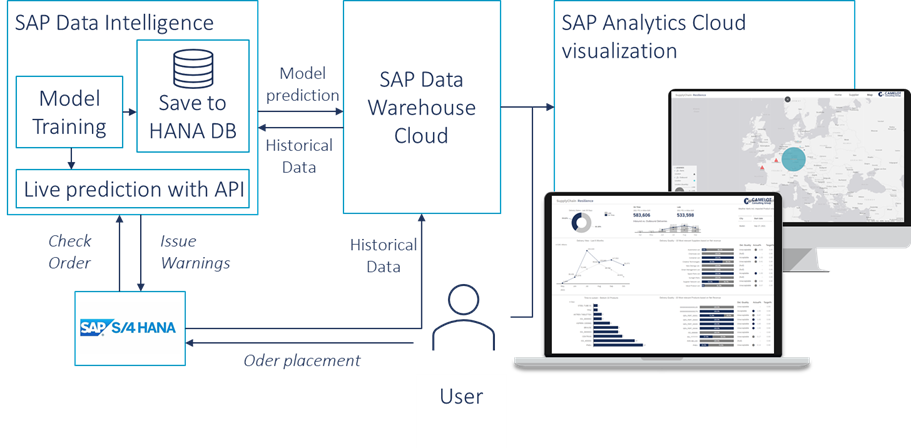In today’s fast and volatile world, it is in competitive supply chains’ very nature to be global and complex. For decades now, supply chains are caught in a crossfire of minor to major disruptions. The Camelot Supply Chain Resilience Cockpit application powered by SAP Data Intelligence and SAP Data Warehouse Cloud analyses how external factors are impacting our supply chains. Integrated with SAP S/4HANA, it offers guided decisions to the users based on historical and current data points.
During the Covid-19 pandemic, many companies experienced first-hand that the susceptibility to disruptions of global supply chains can rise. This is exactly where the “Supply Chain Resilience Cockpit” from Camelot ITLab comes into play. The solution offers companies an always up-to-date overview of difficulties with inbound and outbound deliveries, notifying users in real-time when placing an order in the ECC system. It is designed to enable companies to keep an eye on the impacts of external influencing factors such as governance risks, political unrest, industrial accidents, or natural disasters on the service level of incoming and outgoing shipments at all times. Also taking historical data points into consideration, the solution is able to predict, where delivery problems may occur. The overall goal is to maintain transparency over supply chains and to support the users.
The Supply Chain Resilience Cockpit utilizes data based on the standard extractors of the SAP S/4 HANA system, connected via SAP-DI, external data such as weather forecasts as well as general news reports. Relevant internal and external influencing factors in the SAP Data Warehouse Cloud are used as a central location. This makes information on the various suppliers, and customers transparent and thus sets the course for reliable delivery forecasts. Integrated with SAP S/4HANA, it offers a guided decision support for users. The application combines the industry and process know-how of CAMELOT Management Consultants with the deep technical knowledge of Camelot ITLab to a great added value for companies.
Solution Features
Regional route and sentiment analysis
The solution offers regional route and sentiment analysis considering current, historical, and external data. By integrating external influencing data, the geo-visualization of supply chains including external data and alerts is possible. This deep integration of external data enables users to make high-quality predictions on shifts in the supply chains or disruptions in the process flow. Identified risks are listed for the delivery schedules and the associated supplier locations and alternatives are shown directly when placing an order to disrupt production.
Risk analysis and classification of suppliers
In addition to taking external factors into account, the solution also takes historical data into consideration in order to identify trends and patterns based on suppliers, plants, and routes to calculate delay probabilities. Based on defined KPIs such as Service Level, which are relevant for decision makers, the solution suggests alternative suppliers who could fulfill the order on time.
Integration to customer system landscape such as SAP S/4HANA system
The solution is tightly integrated with the organization’s system landscape and offers guided decision support, e.g., when placing an order in the SAP S/4HANA system. The user is informed about potential delays before the order placement and proposed alternatives. The solution can be integrated to operational systems such as ECC or CRM systems, mass data of data lake (hyperscalers), or further external data sources via APIs.
Benefits
Enhanced transparency
The solution enables greater visibility and transparency of end-to-end supply chain processes taking current and historical data points into consideration. This leads to an optimized prediction of major supply chain disruptions and to an overall more resilient supply chain.
Increase efficiency
As the decision makers are informed about potential delays or risks in real-time when placing an order, this leads to an overall increase in efficiency of supply chain processes. By directly proposing alternatives to the user, the respective orders arrive on time, so processes are not disrupted.
Cover end-to-end processes
By tightly integrating into the SAP S/4HANA order process, the solution considers relevant data and therefore covers end-to-end processes which are relevant for decision making. Potential integration to further operational systems, as well as internal and external data points, the solution becomes an enabler for smooth end-to-end supply chain process execution.
Technical information
The solution leverages SAP Data Intelligence, SAP Data Warehouse cloud as well as integration to multiple data sources. While SAP Data Warehouse Cloud is acting as a main storage between SAP Data Intelligence, SAP Analytics Cloud and S/4HANA SAP Data Intelligence is the core orchestrating point of the solution. It allows for communication between the system landscape. As such, SAP Data Intelligence acts as the host of the Camelot advanced forecasting tools, utilizing machine learning to generate live predictions and issue recommendations and warnings. Hence, SAP Data Intelligence generates a probabilistic model, purchase orders are processed, and result predictions are saved in HANA DB in DWC to feed the dashboard in the SAP Analytics Cloud. An API is created in SAP DI to serve model results live in S/4HANA when a user is placing a purchase order.
Want to learn more?
You want to learn more about Camelot’s Data Intelligence and Data Warehouse Cloud solutions? Check out the following information or visit our resources:
- Customer Use Case Evonik
- INTELLIGENT RULE MINING SOLUTION
- Cadet
Interested? Contact us directly via dataintelligence@camelot-group.com.

